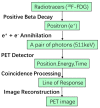Sensors for Positron Emission Tomography Applications
- PMID: 31744258
- PMCID: PMC6891456
- DOI: 10.3390/s19225019
Sensors for Positron Emission Tomography Applications
Abstract
Positron emission tomography (PET) imaging is an essential tool in clinical applications for the diagnosis of diseases due to its ability to acquire functional images to help differentiate between metabolic and biological activities at the molecular level. One key limiting factor in the development of efficient and accurate PET systems is the sensor technology in the PET detector. There are generally four types of sensor technologies employed: photomultiplier tubes (PMTs), avalanche photodiodes (APDs), silicon photomultipliers (SiPMs), and cadmium zinc telluride (CZT) detectors. PMTs were widely used for PET applications in the early days due to their excellent performance metrics of high gain, low noise, and fast timing. However, the fragility and bulkiness of the PMT glass tubes, high operating voltage, and sensitivity to magnetic fields ultimately limit this technology for future cost-effective and multi-modal systems. As a result, solid-state photodetectors like the APD, SiPM, and CZT detectors, and their applications for PET systems, have attracted lots of research interest, especially owing to the continual advancements in the semiconductor fabrication process. In this review, we study and discuss the operating principles, key performance parameters, and PET applications for each type of sensor technology with an emphasis on SiPM and CZT detectors-the two most promising types of sensors for future PET systems. We also present the sensor technologies used in commercially available state-of-the-art PET systems. Finally, the strengths and weaknesses of these four types of sensors are compared and the research challenges of SiPM and CZT detectors are discussed and summarized.
Keywords: avalanche photodiode (APD); cadmium zinc telluride (CZT); digital silicon photomultiplier (dSiPM); photomultiplier tubes (PMT); positron emission tomography (PET); silicon photomultiplier (SiPM); single-photon avalanche diode (SPAD).
Conflict of interest statement
The authors declare no conflict of interest.
Figures

















References
-
- Keng F.Y. Clinical Applications of Positron Emission Tomography in Cardiology: A Review. Ann. Acad. Med. Singap. 2004;33:175–182. - PubMed
Publication types
Grants and funding
LinkOut - more resources
Full Text Sources
Other Literature Sources
Research Materials

